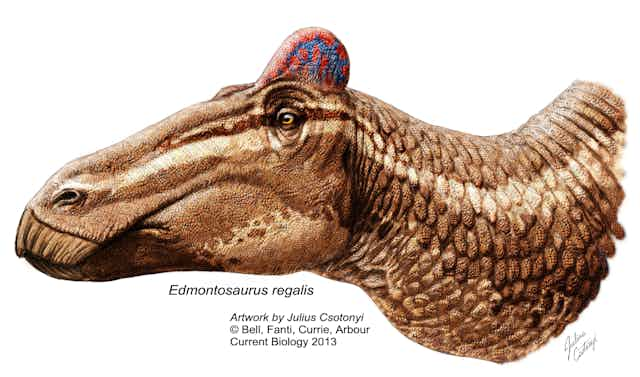The discovery of soft-tissue comb remnants on a fossil could change the way we visualise dinosaurs.
The findings, published today in Current Biology, concern the fossilised remains of an Edmontosaurus regalis skeleton excavated in Alberta, Canada. What makes this specimen notable is the presence of a cranial crest composed entirely of soft tissue — somewhat comparable to a [rooster’s comb](http://en.wikipedia.org/wiki/Comb_(anatomy%29).
This crest is the first of its kind to be found on a dinosaur fossil. While it is unknown whether this characteristic was widespread among duck-billed dinosaurs or limited to the species in question, this discovery suggests that such external attributes may have been more commonplace than once thought.

Study co-author Phil Bell, lecturer at the University of New England, claimed that this was not unlike discovering for the first time that elephants had trunks. The implications for dinosaur research are significant.
“The discovery of feathered dinosaurs 20 years ago was a huge leap forward in our understanding of how these animals looked and behaved,” he said.
“This new discovery is proof that we’re in for more surprises.”
The paper’s authors contend that, given its apparent impracticality for the purposes of breathing, vocalisation, defence or fat storage, the comb was most likely to have been a form of secondary sexual structure.
Bell’s team view this as evidence of the importance of visual signalling in the evolution of this particular dinosaur family, a contrast to the auditory hypothesis (allowing for more sensitive hearing) proposed for the related Lambeosaurinae genus.
John Long, strategic professor in palaeontology at Flinders University, hailed the discovery as “truly fascinating”.
“This opens up a wonderful world where we can imagine dinosaurs with many and varied colourful display structures that they flaunt to attract and woo mates, or to send warnings to other rivals,” he said.
“The mind boggles at the thought.”

While Bell points out that “we still haven’t got the whole picture”, the discovery of the crest is a step towards a more comprehensive understanding of the appearance of dinosaurs. With new fossil imaging technologies at hand and already being used to advantage, Professor Long suggested further revelations are not far away.
“Recent work has shown that we can estimate dinosaur body temperatures from isotopes, and even colour cells are preserved in some species,” he said.
“We will soon have the complete means of accurately restoring what dinosaurs looked like.”
The rarity of such findings to date has been due to several factors. As Bell explained, scientists of previous generations simply weren’t looking in the right places – an oversight that, in the light of these revelations, is unlikely to persist.
“We know in the past that palaeontologists would actually destroy skin impressions because it was perceived that they were less important than the bones,” Bell noted.
“People looked at them and understood that they had scaly skin, end of story. But we’re seeing that this picture is far more complex.”
Even given the best palaeontological practice, however, the chance of finding soft-tissue remnants is still slim.
“They are the parts that most rapidly decay after an animal dies,” Bell pointed out.
This, he said, made the discovery “truly remarkable”.

